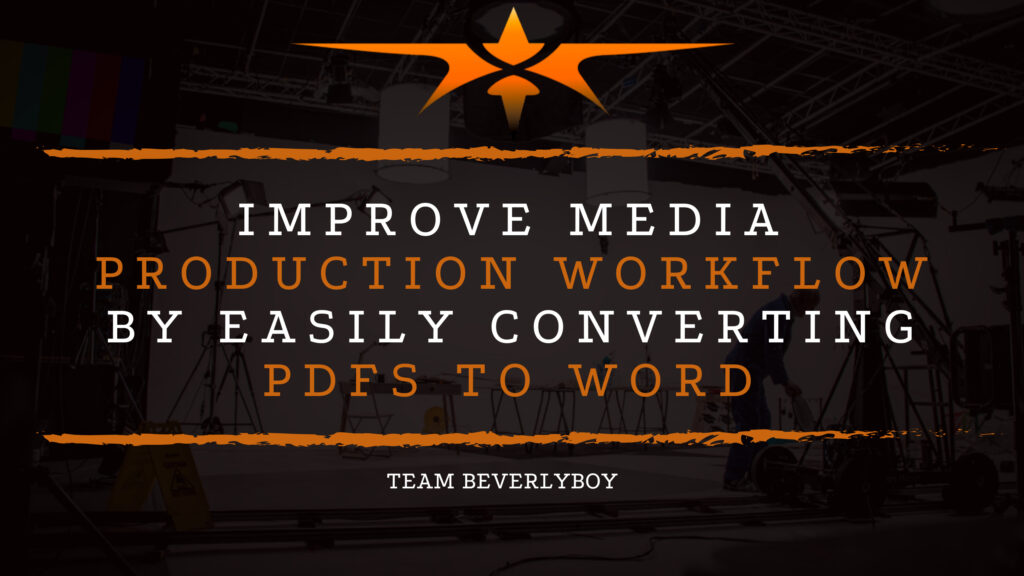Improve Media Production Workflow by Easily Converting PDFs to Word
Besides being of utmost use in communication, content media production also includes documents such as video scripts, lodging of production notes, and writing of project briefs, for example, which are supported by the use of PDFs. Most of these documents are exchanged among teammates, clients, and other project stakeholders, so they need to be formatted and structured in specific ways. PDFs, being image files, pose great difficulty to the media producer as he has to look for ways to edit the same PDF file.

PDF Word conversion is one method that can assist you in editing documents easily without much time wastage because changes take place very fast in this industry, especially in video projects.
How PDFs Are Utilised in Media Production
In media production, specific categories of documents are almost always produced in a single standard format: PDF. Video scripts, project brief documents, contracts, and production notes, such as program outline documents, are often available in PDF form to maintain document structure and fidelity. A project brief explaining the reasons for the production, the target deadline, and the project resources should be prepared in a PDF document to prevent stakeholders from altering this vital information.
However, changing a static PDF file during any production phase can be tricky. If, for example, a team contracts to carry out a particular task but later gets feedback from the client requiring a change in the contract or production notes, the team may face a challenge in adopting the standard PDF editing options, which are relatively unfriendly to users. Such requirements are more common in the production cycle as user needs and the necessary documents change rapidly.
Why Converting PDF to Word Is Important for Media Producers
Changing from PDF to Word enables media experts to work with documents which require editing, such as scripts and production notes. This is how the media producers need this process:
Improved Editing Options
Converting scripts to PDF is a comprehensive task that requires time and biting the bullet. Converting the scripts from the soft new PDF format transforms productivity and professional collaboration. – indicates that the media houses can do many collaborative and fast changes through revised contracts working with templates. Many contracts, even though changing based on actors’ or directors’ inputs, need several modifications on the initial draft. Making deadlines is one of the most frustrating aspects of the production process.
Improved Collaboration
An editable file format bolsters productivity. All team members can make comments, edit, and suggest changes concurrently with a shared Word document. This kind of work is fundamental in media production, as production involves many parts that have to come together.
Increased Productivity
The simplicity of translating documents from PDF to Word accomplishes a great deal in terms of maintaining static files and documents since the organisation of the creative process will surely improve the efficiency of the output.
Streamlined Workflow
Editing documents assist in reducing unnecessary steps in processes. Finding and referring to certain information can be time-consuming and interfere with productivity without electronic access to the files. Real-time accessibility of files for creation, changing things in documents, and sharing them with people leads to faster decision-making and more time spent on core business activities rather than record keeping.
Accessibility and Archiving
Producers and other collaborators can more easily access editable Word documents and obtain and assess the materials wherever they are. Having archived project documents properly in Word ensures easy access to documents from previous projects, thus making it easier to implement new projects while maintaining the production workflow convenient and unchanged.
Tools for Converting PDFs to Word in Media Production
Several media-related instruments have been developed to allow the change of PDF documents into Word. That is why such tools also have some features addressing media. In such cases, the available varieties of PDF software enable the user to perform the function in more than one hundred files at the same time, which is very beneficial, for example, when production teams hand in working scripts and documents that they do not want to convert for hours manually.
Some programs, thanks to OCR, allow editing of scanned PDFs. This is helpful for teams that frequently work on hard-copy documents, as they can monitor and edit content without typing it out.
Making Video Production Process More Efficient with Word Files
The problem of editing PDFs turns out to be a cakewalk the moment the document is converted into the Word format. With writing and project briefs being editable, the producers can change scripts, which improves the quality of the produced work immensely. This means creative processes can be moved forward without the traditional ‘block’ that could arise from the absence of scripts.
It can also result in faster collaboration since clients do not leave the edited graphics for further design processes. Clients are best served when they can make some edits directly on the required documents to preclude rebuilding what has already been constructed in some directed way back for the revision process.
Ensuring Document Accuracy when Producing Media Files
Producers are concerned about monitoring the layout formatting, especially for complex legal documents. Typically, contracts have jurisdictions’ templates, requirements, and warranties that must be fulfilled or clarified. To help maintain document accuracy, it is advisable to use conversion tools that do not compromise the document’s integrity during the conversion, especially the font styles, headings, and bullet points.
In addition to the formatting, it is also essential to follow up on the security of the documents using the best practices to promote accuracy further. All these practices should be followed, especially on sensitive or confidential documents such as contracts, whereby they should be password-protected during editing and sharing to avert any unnecessary alterations.
Practical Guide: Converting PDFs to Word to Complete Media Tasks
Converting a PDF to a Word document is rather easy, and this is the most straightforward option for most media producers who want to convert a PDF to a Word document, for instance. Make sure you have a credible PDF converter that solves your problem first.
- Change Conversion Options: Once you upload files, you can change any conversion options the user requires, for example, whether to keep the original format or textual content only. This level of customisation ensures that the output document meets the criteria of the respective user’s level down the document.
- Check for Correctness: After converting the document, it is prudent to check its accuracy. Avoid any shifts in structural features, such as the arrangement of image formats and tables or the presence of watermarks, which may not be captured during the transfer.
- Add Cloud Storage Services: Increase productivity by adding cloud storage services. These services facilitate the easy retrieval of documents during film production.
Streamline Your Media Production Process by Using PDF to Word Conversion
PDF to Word file conversion approaches the resolution at which the various basic processes involved in media production become efficient. These strategies can also greatly cut the time used on edits and revisions, enabling producers to keep up with the high demand in content production. Adopting these tools makes work easier and facilitates saving, hence concentrating more on the most essential aspect of media production – content creation.
Do not allow complicated PDF files to interfere with the content production flow. Find some solutions for converting PDF to Word and improve the work of your media production team. This technology will change how you create editable documents, and your projects will run even smoother than ever.


